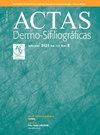[翻译文章]]红斑、局部水肿和发热vs前臂周长增加。是时候修改振动性荨麻疹-血管性水肿涡旋激发试验的共识建议了?
IF 3.8
Q1 DERMATOLOGY
引用次数: 0
摘要
背景与目的:振动性荨麻疹/血管性水肿可通过旋涡激发试验确诊。已经同意测量前臂暴露于漩涡后的周长,以确定对它的积极反应。材料和方法:我们评估了志愿者在振动刺激后出现症状的频率(使用问卷);同一志愿者对旋涡测试的反应(前臂周长增加、红斑、局部水肿、发热和瘙痒);两分的可靠性;以及问卷得分和测试反应之间的相关性。结果:140名志愿者参与。由于人口统计原因,17人被排除在外。在123名无人口统计学特征的调查对象中,59%的人对问卷≥1项有肯定回答。局部红斑、发热或局部水肿占58.5%;38.2%;分别是32.5%。73.6%出现瘙痒。瘙痒的平均强度为3.44 95% CI(2.94 ~ 3.94)。在三个水平上,前臂围度增加的解释一致性较低(组内相关系数:0.477 95% CI: 0.253-0.634;0.496 95% ci: 0.280-0.647;和0.370,95% CI分别为0.100-0.559);红斑、发热、局部水肿效果最佳(Kappa指数:0.868;.756;和。757)。问卷得分与不同变量对测试的改变反应之间存在显著的相关性。结论:我们提出的变量是:红斑;局部水肿;热;并且,瘙痒的强度/发作速度/持续时间,以定义对漩涡测试的积极响应,因为它们易于执行和最佳的观察者间协议。本文章由计算机程序翻译,如有差异,请以英文原文为准。
![[Translated article] Erythema, Localized Edema and Heat vs Forearm Perimeter Increase. Time to Revise the Consensus Recommendations on the Vortex Provocation Test in Vibratory Urticaria–Angioedema?](https://img.booksci.cn/booksciimg/2025-4/101302613101774266723.jpg)
[Translated article] Erythema, Localized Edema and Heat vs Forearm Perimeter Increase. Time to Revise the Consensus Recommendations on the Vortex Provocation Test in Vibratory Urticaria–Angioedema?
Background and objective
Diagnosis of vibratory urticaria/angioedema is established after performing the vortex provocation test. There is current consensus on measuring the forearm perimeter after running such test to define a positive response to it.
Material and method
We evaluated the frequency of prior symptoms following vibratory stimuli in volunteers using a questionnaire, response to the vortex provocation test in the same volunteers (increase in forearm perimeter, erythema, localized edema, heat, and pruritus), inter-rater reliability, and correlation between the scores obtained in the questionnaire and response to the test.
Results
A total of 40 volunteers participated in this survey, 17 of whom were excluded due to dermographism. A total of 59% out of 123 without dermographism responded positively to ≥1 items of the questionnaire. Localized erythema, heat or localized edema were reported in 58.5%, 38.2%, and 32.5%, respectively. A total of 73.6% of volunteers presented with itch. The mean intensity of itch was 3.44, 95% CI, 2.94–3.94. Inter-rater agreement was low regarding the increase in forearm circumference at three levels (intraclass correlation coefficient, 0.477, 95% CI: 0.253–0.634; 0.496, 95% CI: 0.280–0.647; and 0.370, 95% CI: 0.100–0.559, respectively) and optimal regarding erythema, heat and localized edema (kappa index, 0.868; 0.756; and 0.757, respectively). A significant correlation was identified between the questionnaire score and the altered response to the test in its different variables.
Conclusions
We propose the following variables: erythema; localized edema; heat; and the intensity/speed of onset/duration of pruritus to define a positive response to the vortex provocation test given their ease of execution and optimal inter-observer agreement.
求助全文
通过发布文献求助,成功后即可免费获取论文全文。
去求助
来源期刊

Actas dermo-sifiliograficas
DERMATOLOGY-
CiteScore
1.90
自引率
9.40%
发文量
473
审稿时长
56 weeks
期刊介绍:
Actas Dermo-Sifiliográficas, publicación Oficial de la Academia Española de Dermatología y Venereología, es una revista de prestigio consolidado. Creada en 1909, es la revista mensual más antigua editada en España.En 2006 entró en Medline, y hoy resulta imprescindible para estar al día sobre la dermatología española y mundial.
 求助内容:
求助内容: 应助结果提醒方式:
应助结果提醒方式:


